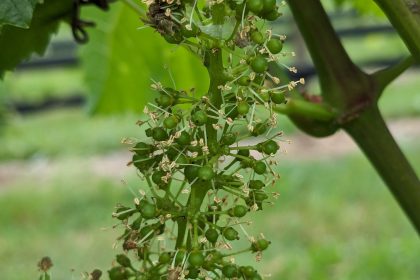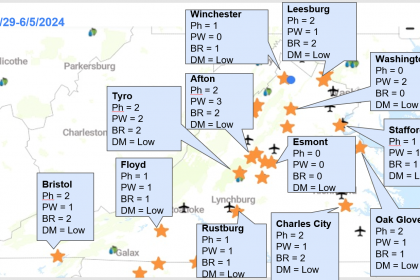It has been another rainy weekend (1.5 inches so far and still counting), and looks like next weekend will be wet again… Hopefully, this year won’t as wet as the 2018 season…
Hopefully, you can provide good protection before the rain, but even if you did, rain more than 1-2 inches can wash the material away from the canopy. Dr. Annemiek Schilder at Michigan State University has a great article about rain and wash off of fungicide. Her work suggests that although only a 0.04 inch of rain can wash a certain percentage of a material from the leaf, it takes about 1-2 inches to actually having a negative effect on the efficacy since the rate you apply is typically much higher than the threshold for the efficacy of the material.
When we have the next chance of application, what material(s) should we apply? I think many of us are about 2-4 weeks away from the bloom, so, the major concern is downy mildew. If you think you have missed the window (e.g., there were more than 2 inches of rain from the last application of a fungicide against downy mildew, or it has been more than 10 days from the previous application and you were not able to cover before 1-2 inches of rain), it is probably a good idea to have a phosphite material (FRAC = P07) such as Prophyt, Phostrol, etc. It has a kickback activity against downy mildew (i.e., it can stop the ongoing infection process). While you are at it, it probably a good idea to mix with a protective material (e.g., captan (FRAC = M4), or mancozeb, ziram (FRAC = M3), or Revus, Forum (FRAC = 40), or Zampro (FRAC = 40+45), or Ranman (FRAC = 21)). (Please note that there is an increasing case of Revus resistant downy mildew isolates in VA. Make sure to spray before the rain!)
If your vines are within two weeks of bloom, it is probably better to include mancozeb plus a QoI (FRAC = 11, e.g. Abound, Flint, etc) or a DMI (FRAC = 3, e.g., Rally, Mettle, etc) for black rot. There is a difference between the QoI and DMI in regards to their kickback activity against black rot. In between them, the DMI is known to have a better (i.e., reach out longer) kickback activity than the QoI. So if you are in doubt about black rot, a DMI maybe a better option.
Ridomil products (FRAC = 4 + M3 (MZ) or + M1(Copper)) have excellent kick-back activity against downy mildew. Typically, I recommend the use of phosphite as noted above because Ridomil products have known fungicide resistance issue. Thus, Ridomil products could be a good option if you are concerned about a lack of coverage, and you want to have a very good material to stop the on-going infection. Please make sure not to spray too many times. Although you could apply up to four times according to the label, my recommendation is to limit the use of it to twice a season. We have too many fungicide resistance issues in our state, and the overuse (and misuse) of a product is the most likely cause. Also, although Ridomil MZ has mancozeb, the concentration of mancozeb will be less than our typical recommendation (3 lb/A). You may want to adjust it by adding mancozeb (to meet 3 lb/A) or other a material(s) to cover black rot.
The other potential scenario is that you have applied materials just before the recent rain events, so, you might not be too concerned about the missing window, but you want to have an insurance against the upcoming rain event(s). In such a case, a copper (FRAC = M1) material might be a good fit. It is more economical than other materials, has good efficacy against downy mildew, and it tends to do better under frequent rain condition. There are several newer copper materials that cause fewer phytotoxicity issues even on relatively copper sensitive cultivars (e.g., Cueva, Champ, etc). Another option is captan (FRAC = M4). Both copper and captan material are not effective against black rot, so, if your vines are near bloom, make sure to have mancozeb plus a QoI or a DMI for black rot.
One of the reasons why I mention about copper and captan is because of the use limitation of mancozeb. In addition to the well-known 66-day PHI, there is a limitation in the amount of mancozeb can be used for each year, which is about 19 lb per acre per year. (Please refer to the label for the specific number for your product.)
Lastly, just because we have many rains, it won’t stop powdery mildew. Make sure to have a powdery mildew material (sulfur, FRAC = M2, or others) in your tank-mix.






